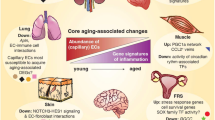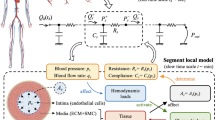Abstract
The large conductance Ca2+-activated K+ (BKCa) channel in vascular smooth muscle cell (VSMC) is an important potassium channel that can regulate vascular tone. Recent work has demonstrated that abnormalities in BKCa channel function are associated with changes in cell proliferation and the onset of vascular disease. However, until today there are rare reports to show whether this channel is involved in VSMC proliferation in response to fluid shear stress (SS). Here we investigated a possible role of BKCa channel in VSMC proliferation under laminar SS. Rat aortic VSMCs were plated in parallel-plate flow chambers and exposed to laminar SS with varied durations and magnitudes. VSMC proliferation was assessed by measuring proliferating cell nuclear antigen (PCNA) expression and DNA synthesis. BKCa protein and gene expression was determined by flow cytometery and RT-PCR. The involvement of BKCa in SS-induced inhibition of proliferation was examined by BKCa inhibition using a BKCa specific blocker, iberiotoxin (IBTX), and by BKCa transfection in BKCa non-expressing CHO cells. The changes in [Ca2+]i were determined using a calcium-sensitive dye, fluo 3-AM. Membrane potential changes were detected with a potential-sensitive dye, DiBAC4(3). We found that laminar SS inhibited VSMC proliferation and stimulated BKCa channel expression. Furthermore, laminar SS induced an increase in [Ca2+]i and membrane hyperpolarization. Besides in VSMC, the inhibitory effect of BKCa channel activity on cell proliferation in response to SS was also confirmed in BKCa-transfected CHO cells showing a decline in proliferation. Blocking BKCa channel reversed its inhibitory effect, providing additional support for the involvement of BKCa in SS-induced proliferation reduction. Our results suggest, for the first time, that BKCa channel mediates laminar SS-induced inhibition of VSMC proliferation. This finding is important for understanding the mechanism by which SS regulates VSMC proliferation, and should be helpful in developing strategies to prevent flow-initiated vascular disease formation.






Similar content being viewed by others
References
Ainslie KM, Garanich JS, Dull RO, Tarbell JM (2005) Vascular smooth muscle cell glycocalyx influences shear stress-mediated contractile response. J Appl Physiol 98:242–249
Albarwani S, Al-Siyabi S, Baomar H, Hassan MO (2001) Exercise training attenuates ageing-induced BKCa channel downregulation in rat coronary arteries. Exp Physiol 95:746–755
Amberg GC, Fernando Santana L (2003) Downregulation of the BK channel β1 subunit in genetic hypertension. Circ Res 93:965–971
Brakemeier S, Kersten A, Eichler I, Grgic I, Zakrzewicz A, Hopp H, Köhler R, Hoyer J (2003) Shear stress-induced up-regulation of the intermediate-conductance Ca2+-activated K+ channel in human endothelium. Cardiovasc Res 60:488–496
Burg ED, Remillard CV, Yuan JXJ (2008) Potassium channels in the regulation of pulmonary artery smooth muscle cell proliferation and apoptosis: pharmacotherapeutic implications. Br J Pharmacol Mar 153:S99–S111
Cidad P, Moreno-Dominguez A, Novensa L, Roque M, Barquin L, Heras M, Perez-Garcia MT, Lopez-Lopez JR (2010) Characterization of ion channels involved in the proliferative response of femoral artery smooth muscle cells. Arterioscler Thromb Vasc Biol 30:1203–1211
Civelek M, Ainslie K, Garanich JS, Tarbell JM (2002) Smooth muscle cells contract in response to fluid flow via a Ca2+-independent signaling mechanism. J Appl Physiol 93:1907–1917
Cogolludo A, Frazziano G, Briones AM et al (2007) The dietary flavonoid quercetin activates BKCa currents in coronary arteries via production of H2O2. Role in vasodilatation. Cardiovasc Res 73:424–431
Cui JM, Yang HE, Lee US (2009) Molecular mechanisms of BK channel activation. Cell Mol Life Sci 66:852–879
Ekstrand J, Razuvaev A, Folkersen L, Roy J, Hedin U (2010) Tissue factor pathway inhibitor-2 is induced by fluid shear stress in vascular smooth muscle cells and affects cell proliferation and survival. J Vasc Surg 52:167–175
Ghatta S, Nimmagadda D, Xu X, O'Rourke ST (2006) Large-conductance, calcium-activated potassium channels: structural and functional implications. Pharmacol Ther 110:103–116
Haga M, Yamashita A, Paszkowiak J, Sumpio BE, Dardik A (2003) Oscillatory shear stress increases smooth muscle cell proliferation and Akt phosphorylation. J Vasc Surg 37(6):1277–1284
Huo B, Lu XL, Hung CT, Costa KD, Xu Q, Whitesides GM, Guo XE (2008) Fluid flow induced calcium response in bone cell network. Cell Mol Bioeng 1:58–66
Jackson WF (2005) Potassium channels and proliferation of vascular smooth muscle cells. Circ Res 97:1211–1212
Kraft R, Krause P, Jung S, Basrai D, Liebmann L, Bolz J, Patt S (2003) BK channel openers inhibit migration of human glioma cells. Pflugers Arch 446:248–255
Kraiss LW, Kirkman TR, Kohler TR, Zierler B, Clowes AW (1991) Shear stress regulates smooth muscle proliferation and neointimal thickening in porous polytetrafluoroethylene grafts. Arterioscler Thromb 11:1844–1852
Li YS, Haga JH, Chien S (2005) Molecular basis of effects of shear stress on vascular stress on vascular endothelial cells. J Biomech 38:1949–1971
Li P, Hu M, Sun S, Zhang Y, Gao Y, Long M, Huo B, Zhang D (2012) Fluid flow-induced calcium response in early or late differentiated osteoclasts. Ann Biomed Eng 40:1874–1883
Li CH, Xu QB (2007) Mechanical stress-initiated signal transduction in vascular smooth muscle cells in vitro and in vivo. Cell Signal 19(5):881–891
McGahon MK, Zhang X, Scholfield CN, Curtis TM, McGeown JG (2007) Selective downregulation of the BK β1 subunit in diabetic arteriolar myocytes. Channels 1:141–143
Motobu M, Wang P-C, Matsumura M (1998) Effect of shear stress on recombinant Chinese hamster ovary cells. J Ferment Bioeng 85:190–195
Ngai CY, Yao X (2010) Vascular responses to shear stress: the involvement of mechanosensors in endothelial cells. Open Circ Vasc J 3:85–94
Nishimaru K, Eghbali M, Lu R, Marijic J, Stefani E, Toro L (2004) Functional and molecular evidence of MaxiK channel β1 subunit decrease with coronary artery aging in the rat. J Physiol 559:849–862
Orio P, Rojas P, Ferreira G, Latorrel R (2002) New disguises for an old channel: MaxiK channel β-subunits. News Physiol Sci 17:156–161
Paolocci N, Pagliaro P, Isoda T, Saavedra FW, Kass DA (2001) Role of calcium-sensitive K+ channels and nitric oxide in vivo coronary vasodilation from enhanced perfusion pulsatility. Circulation 103:119–124
Patterson AJ, Henrie-Olson J, Brenner R (2002) Vasoregulation at the molecular level: a role for the β1 subunit of the calcium-activated potassium (BK) channel. Trends Cardiovasc Med 12:78–82
Qi YX, Qu MJ, Long DK, Liu B, Yao QP, Chien S, Jiang ZL (2008) Rho-GDP dissociation inhibitor alpha downregulated by low shear stress promotes vascular smooth muscle cell migration and apoptosis: a proteomic analysis. Cardiovasc Res 80(1):114–122
Rensen SS, Doevendans PA, van Eys GJ (2007) Regulation and characteristics of vascular smooth muscle cell phenotypic diversity. Neth Heart J 15:100–108
Romanenko VG, Thompson J, Begenisich T (2010) Ca2+-activated K+ channels in parotid acinar cells: the functional basis for the hyperpolarized activation of BK channels. Channels 4:278–288
Rusch NJ (2009) BK channels in cardiovascular disease: a complex story of channel dysregulation. Am J Physiol 297:H1580–H1582
Sharma R, Yelloeley CE, Civelek M, Ainslie K, Hodgson L, Tarbell JM, Donahue HJ (2002) Intracellular calcium changes in rat aortic smooth muscle cells in response to fluid flow. Ann Biomed Eng 30:371–378
Shi ZD, Abraham G, Tarbell JM (2010) Shear stress modulation of smooth muscle cell marker genes in 2-D and 3-D depends on mechanotransduction by heparan sulfate proteoglycans and ERK1/2. PLoS One 5:e12196
Shi ZD, Tarbell JM (2011) Fluid flow mechanotransduction in vascular smooth muscle cells and fibroblasts. Ann Biomed Eng 39:1608–1619
Spitzner M, Ousingsawat J, Scheidt K, Kunzelmann K, Schreiber R (2007) Voltage-gated K+ channels support proliferation of colonic carcinoma cells. FASEB J 21:35–44
Sun D, Huang A, Koller A, Kaley G (2001) Endothelial KCa channels mediate flow-dependent dilation of arterioles of skeletal muscle and mesentery. Microvasc Res 61:179–186
Sundelacruz S, Levin M, Kaplan DL (2009) Role of membrane potential in the regulation of cell proliferation and differentiation. Stem Cell Rev 5:231–246
Tarbell JM, Shi ZD. (2012) Effect of the glycocalyx layer on transmission of interstitial flow shear stress to embedded cells. Biomech Model Mechanobiol. doi 10.1007/s10237-012-0385-0388
Ueba H, Kawakami M, Yaginuma T (1997) Shear stress as an inhibitor of vascular smooth muscle cell proliferation. Role of transforming growth factor-beta 1 and tissue-type plasminogen activator. Arterioscler Thromb Vasc Biol 17:1512–1516
Yamada A, Gaja N, Ohya S, Muraki K, Narita H, Ohwada T, Imaizumi Y (2001) Usefulness and limitation of DiBAC4(3), a voltage-sensitive fluorescent dye, for the measurement of membrane potentials regulated by recombinant large conductance Ca2+-activated K+ channels in HEK293 cells. Jpn J Pharmacol 86:342–350
Yang HE, Zhang GH, Shi JY, Lee US, Delaloye K, Cui JM (2008) Subunit-specific effect of the voltage sensor domain on Ca2+ sensitivity of BK channels. Biophys J 94:4678–4687
Yoshida H, Kawane K, Koike M, Mori Y, Uchiyama Y, Nagata S (2005) Phosphatidylserine-dependent engulfment by macrophages of nuclei from erythroid precursor cells. Nature 437:754–758
Zhao H, Sokabe M (2008) Tuning the mechanosensitivity of a BK channel by changing the linker length. Cell Res 18:871–878
Zhao HC, Wang F (2010) Exercise training changes the gating properties of large-conductance Ca2+-activated K+ channels in rat thoracic aorta smooth muscle cells. J Biomech 43:263–267
Acknowledgments
The authors wish to thank Dr. Zhong-Dong Shi from Developmental Biology Program of Sloan-Kettering Institute for his helpful suggestions. We would also like to express our deep gratitude to Daniela C. Georgieva from Developmental Biology Program of Sloan-Kettering Institute for her help in polishing this paper. This work was supported by the National Natural Science Foundation of China (Nos. 10972024, 11120101001, 10925208 and 10802006). National Basic Research Program of China (973 program, 2011CB710901)
Conflict of interest
None.
Author information
Authors and Affiliations
Corresponding author
Electronic supplementary material
Below is the link to the electronic supplementary material.
Supplement Figure 1
A B: The acquired VSMC is positively α-SMA-stained (A) or SM-MHC-1-stained (B). Green, α-SMA positive stain; Red, SM-MHC-1 positive stain; Blue, nuclear stain. (JPEG 16 kb)
High Resolution Image
(TIFF 7512 kb)
Supplementary Figure 2
A B C D. BKCa transfections in CHO cells were observed by laser confoco microscopy (upper panel) and quantified by flow cytometry (bottom panel). Both α-subunit (A) and β1-subunit (B) were expressed in transfected CHO cells. Green, α-subunit positive stain; Red, β1-subunit positive stain; Blue, nuclear stain. The transfection rate was 98.7 % for α-subunit (C) and 99.8 % for β1-subunit (D). (JPEG 31 kb)
High Resolution Image
(TIFF 14308 kb)
Supplementary Figure 3
Schematic drawing of the shear apparatus. Culture medium pumped into upper reservoir. The liquid surface of upper reservoir was steady. Therefore, the height of upper reservoir controlled the fluid flow rate, further controlled the magnitude of wall shear stress flown over VSMCs monolayer. (JPEG 16 kb)
High Resolution Image
(TIFF 2572 kb)
Supplementary Figure 4
A B. Blockade of BKCa channel increases the PCNA fluorescence intensity of VSMCs in shear cases, but has no effect in static cases. A. Shear cases. B. Static cases. Green, FITC stained PCNA; Blue, DAPI-stained nuclear. Representative laser confoco microscope graphs for static cases. Green, FITC stained PCNA; Blue, DAPI-stained nuclear. (JPEG 189 kb)
High Resolution Image
(TIFF 16518 kb)
Supplementary Figure 4
C D. Blockade of BKCa channel promotes cell cycle progress of VSMCs subjected to the described laminar SS for 12 h (D) and 24 h (E). (JPEG 123 kb)
High Resolution Image
(TIFF 16007 kb)
Supplementary Figure 5
The expression of BKCa channel has no alteration after IBTX treatment. (A) α- subunit ; (B) β1-subunit. (JPEG 15 kb)
High Resolution Image
(TIFF 1832 kb)
Supplementary Figure 6
The PCNA decrease was effectively reversed by the IBTX treatment in shear cases, but had no effects in static cases. (A) Representative laser confoco microscope graphs. (B) Values of the PCNA fluorescent intensity with and without BKCa blockade. *P < 0.05, No blockade (α+/β1+) vs t blockade (α+/β1++ IBTX) (n = 3). (JPEG 102 kb)
High Resolution Image
(TIFF 11760 kb)
ESM 8
(DOCX 27 kb)
Rights and permissions
About this article
Cite this article
Jia, X., Yang, J., Song, W. et al. Involvement of large conductance Ca2+-activated K+ channel in laminar shear stress-induced inhibition of vascular smooth muscle cell proliferation. Pflugers Arch - Eur J Physiol 465, 221–232 (2013). https://doi.org/10.1007/s00424-012-1182-z
Received:
Revised:
Accepted:
Published:
Issue Date:
DOI: https://doi.org/10.1007/s00424-012-1182-z




